The Effects of Marzano's Strategies on English Teachers' Performance
VerifiedAdded on 2020/04/01
|25
|6315
|138
Report
AI Summary
This report investigates the impact of Marzano’s instructional strategies and vocabulary processes on English language teachers' performance in teaching reading and vocabulary, as well as their attitudes towards these strategies. The study explores various aspects of Marzano's method, including providing descriptions, explanations, examples, and engaging students in activities and games to improve vocabulary. It also examines the importance of critical and creative thinking, thinking processes, core thinking skills, and connecting thinking to content knowledge within Marzano's framework. Furthermore, the report references Bruner's Theory of Instruction and discusses positive attitudes towards learning, the acquisition and integration of knowledge, and productive habits of mind. The research also addresses instructional strategies and second language pedagogical theories, including integrated instruction and developmentally appropriate practices. The report aims to provide insights into enhancing teaching effectiveness and improving student outcomes in English language learning environments.
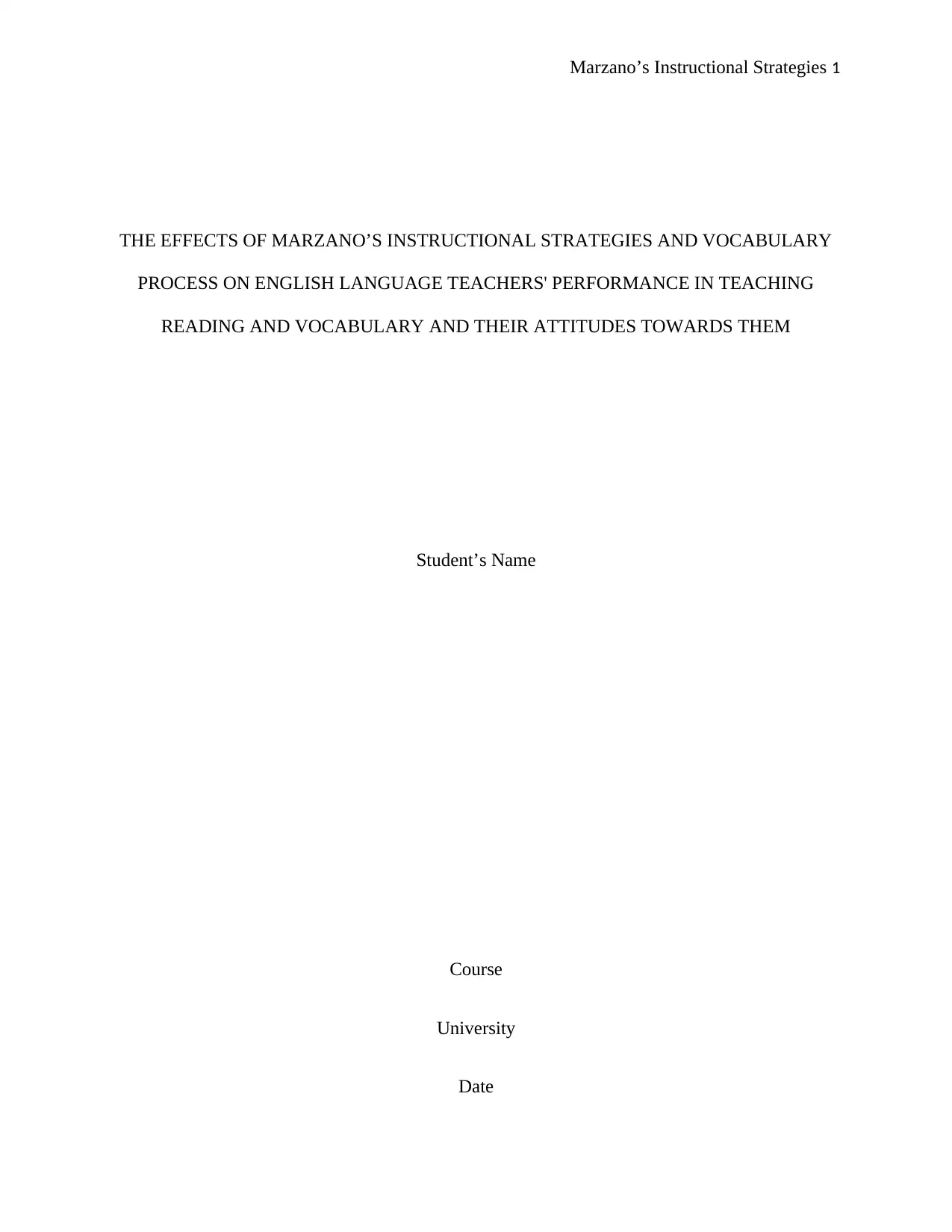
Marzano’s Instructional Strategies 1
THE EFFECTS OF MARZANO’S INSTRUCTIONAL STRATEGIES AND VOCABULARY
PROCESS ON ENGLISH LANGUAGE TEACHERS' PERFORMANCE IN TEACHING
READING AND VOCABULARY AND THEIR ATTITUDES TOWARDS THEM
Student’s Name
Course
University
Date
THE EFFECTS OF MARZANO’S INSTRUCTIONAL STRATEGIES AND VOCABULARY
PROCESS ON ENGLISH LANGUAGE TEACHERS' PERFORMANCE IN TEACHING
READING AND VOCABULARY AND THEIR ATTITUDES TOWARDS THEM
Student’s Name
Course
University
Date
Paraphrase This Document
Need a fresh take? Get an instant paraphrase of this document with our AI Paraphraser
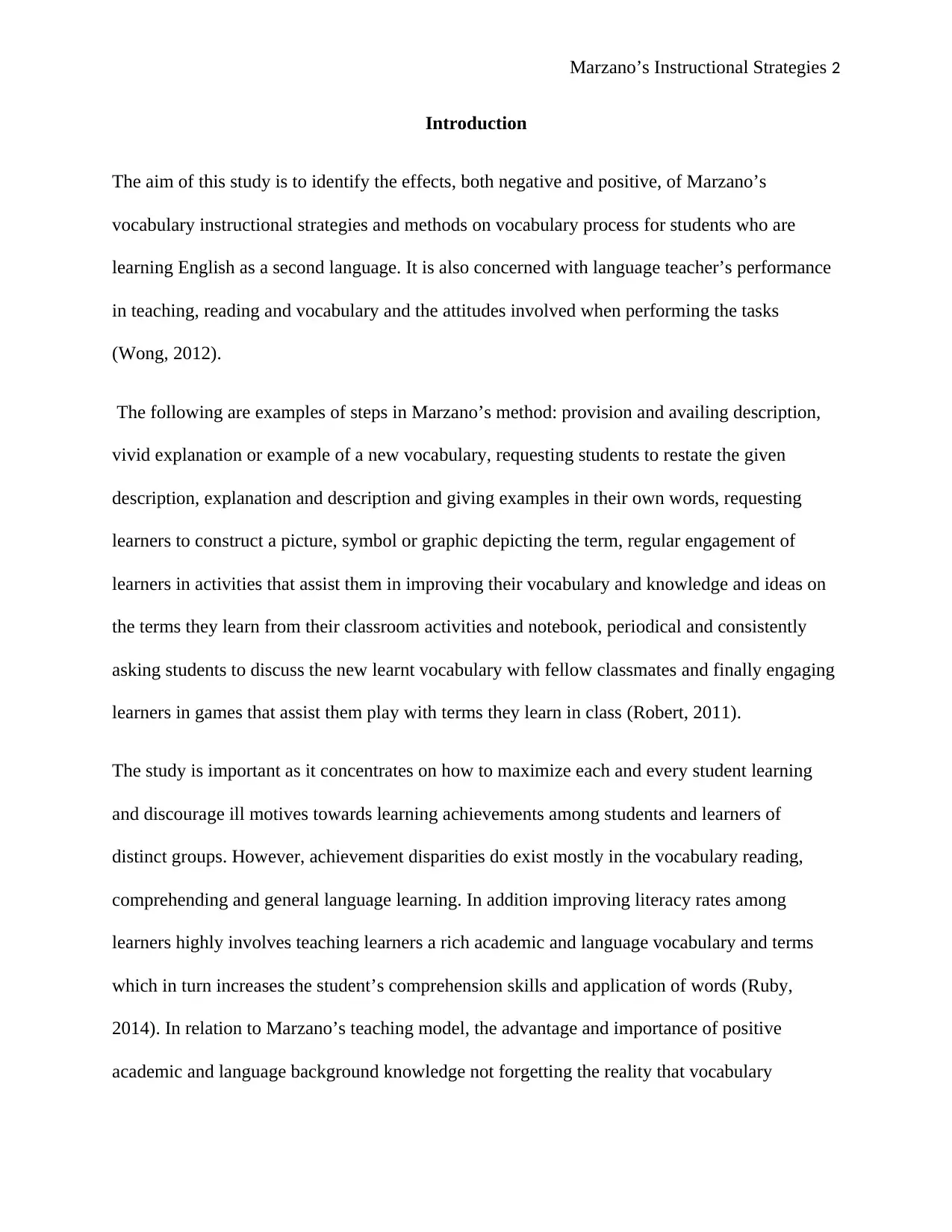
Marzano’s Instructional Strategies 2
Introduction
The aim of this study is to identify the effects, both negative and positive, of Marzano’s
vocabulary instructional strategies and methods on vocabulary process for students who are
learning English as a second language. It is also concerned with language teacher’s performance
in teaching, reading and vocabulary and the attitudes involved when performing the tasks
(Wong, 2012).
The following are examples of steps in Marzano’s method: provision and availing description,
vivid explanation or example of a new vocabulary, requesting students to restate the given
description, explanation and description and giving examples in their own words, requesting
learners to construct a picture, symbol or graphic depicting the term, regular engagement of
learners in activities that assist them in improving their vocabulary and knowledge and ideas on
the terms they learn from their classroom activities and notebook, periodical and consistently
asking students to discuss the new learnt vocabulary with fellow classmates and finally engaging
learners in games that assist them play with terms they learn in class (Robert, 2011).
The study is important as it concentrates on how to maximize each and every student learning
and discourage ill motives towards learning achievements among students and learners of
distinct groups. However, achievement disparities do exist mostly in the vocabulary reading,
comprehending and general language learning. In addition improving literacy rates among
learners highly involves teaching learners a rich academic and language vocabulary and terms
which in turn increases the student’s comprehension skills and application of words (Ruby,
2014). In relation to Marzano’s teaching model, the advantage and importance of positive
academic and language background knowledge not forgetting the reality that vocabulary
Introduction
The aim of this study is to identify the effects, both negative and positive, of Marzano’s
vocabulary instructional strategies and methods on vocabulary process for students who are
learning English as a second language. It is also concerned with language teacher’s performance
in teaching, reading and vocabulary and the attitudes involved when performing the tasks
(Wong, 2012).
The following are examples of steps in Marzano’s method: provision and availing description,
vivid explanation or example of a new vocabulary, requesting students to restate the given
description, explanation and description and giving examples in their own words, requesting
learners to construct a picture, symbol or graphic depicting the term, regular engagement of
learners in activities that assist them in improving their vocabulary and knowledge and ideas on
the terms they learn from their classroom activities and notebook, periodical and consistently
asking students to discuss the new learnt vocabulary with fellow classmates and finally engaging
learners in games that assist them play with terms they learn in class (Robert, 2011).
The study is important as it concentrates on how to maximize each and every student learning
and discourage ill motives towards learning achievements among students and learners of
distinct groups. However, achievement disparities do exist mostly in the vocabulary reading,
comprehending and general language learning. In addition improving literacy rates among
learners highly involves teaching learners a rich academic and language vocabulary and terms
which in turn increases the student’s comprehension skills and application of words (Ruby,
2014). In relation to Marzano’s teaching model, the advantage and importance of positive
academic and language background knowledge not forgetting the reality that vocabulary
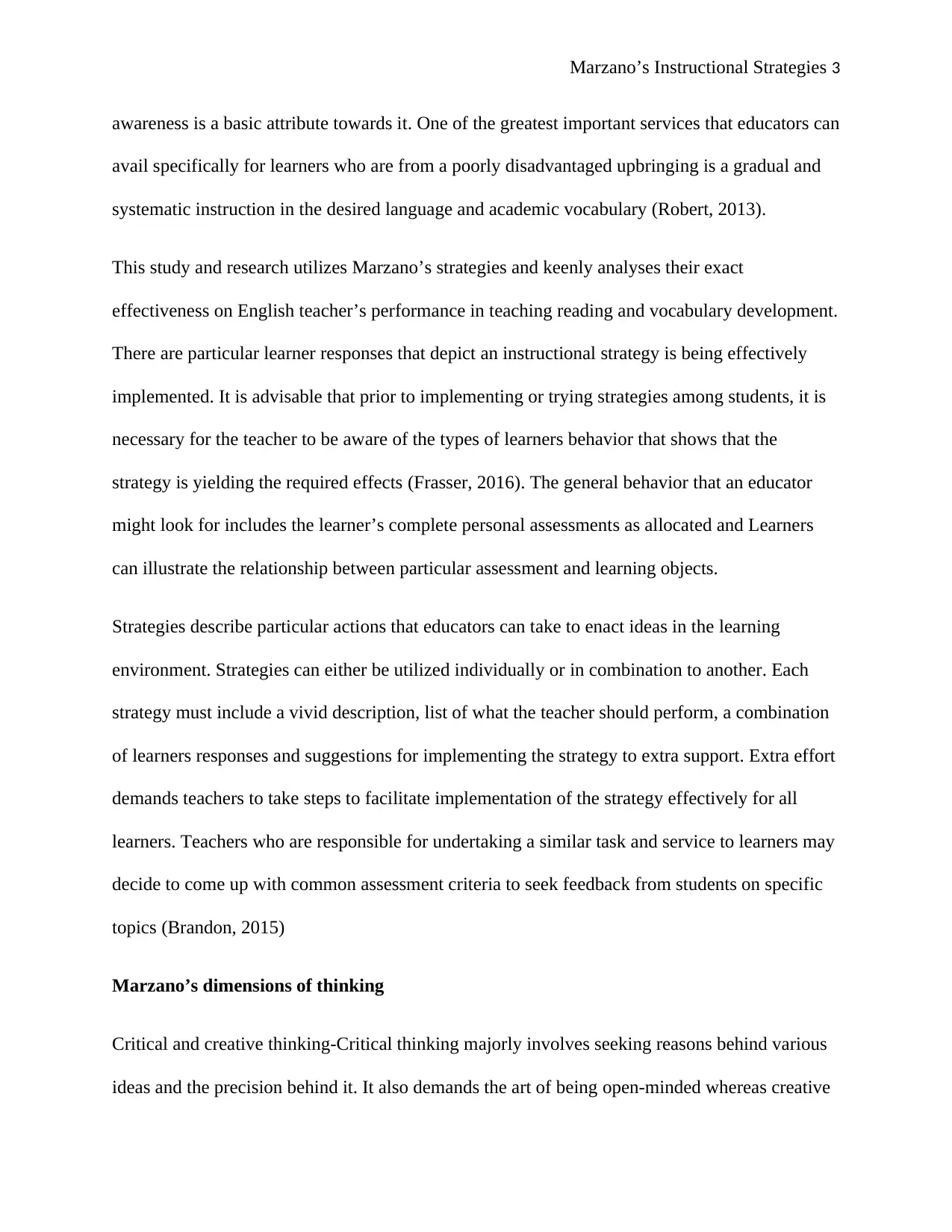
Marzano’s Instructional Strategies 3
awareness is a basic attribute towards it. One of the greatest important services that educators can
avail specifically for learners who are from a poorly disadvantaged upbringing is a gradual and
systematic instruction in the desired language and academic vocabulary (Robert, 2013).
This study and research utilizes Marzano’s strategies and keenly analyses their exact
effectiveness on English teacher’s performance in teaching reading and vocabulary development.
There are particular learner responses that depict an instructional strategy is being effectively
implemented. It is advisable that prior to implementing or trying strategies among students, it is
necessary for the teacher to be aware of the types of learners behavior that shows that the
strategy is yielding the required effects (Frasser, 2016). The general behavior that an educator
might look for includes the learner’s complete personal assessments as allocated and Learners
can illustrate the relationship between particular assessment and learning objects.
Strategies describe particular actions that educators can take to enact ideas in the learning
environment. Strategies can either be utilized individually or in combination to another. Each
strategy must include a vivid description, list of what the teacher should perform, a combination
of learners responses and suggestions for implementing the strategy to extra support. Extra effort
demands teachers to take steps to facilitate implementation of the strategy effectively for all
learners. Teachers who are responsible for undertaking a similar task and service to learners may
decide to come up with common assessment criteria to seek feedback from students on specific
topics (Brandon, 2015)
Marzano’s dimensions of thinking
Critical and creative thinking-Critical thinking majorly involves seeking reasons behind various
ideas and the precision behind it. It also demands the art of being open-minded whereas creative
awareness is a basic attribute towards it. One of the greatest important services that educators can
avail specifically for learners who are from a poorly disadvantaged upbringing is a gradual and
systematic instruction in the desired language and academic vocabulary (Robert, 2013).
This study and research utilizes Marzano’s strategies and keenly analyses their exact
effectiveness on English teacher’s performance in teaching reading and vocabulary development.
There are particular learner responses that depict an instructional strategy is being effectively
implemented. It is advisable that prior to implementing or trying strategies among students, it is
necessary for the teacher to be aware of the types of learners behavior that shows that the
strategy is yielding the required effects (Frasser, 2016). The general behavior that an educator
might look for includes the learner’s complete personal assessments as allocated and Learners
can illustrate the relationship between particular assessment and learning objects.
Strategies describe particular actions that educators can take to enact ideas in the learning
environment. Strategies can either be utilized individually or in combination to another. Each
strategy must include a vivid description, list of what the teacher should perform, a combination
of learners responses and suggestions for implementing the strategy to extra support. Extra effort
demands teachers to take steps to facilitate implementation of the strategy effectively for all
learners. Teachers who are responsible for undertaking a similar task and service to learners may
decide to come up with common assessment criteria to seek feedback from students on specific
topics (Brandon, 2015)
Marzano’s dimensions of thinking
Critical and creative thinking-Critical thinking majorly involves seeking reasons behind various
ideas and the precision behind it. It also demands the art of being open-minded whereas creative
⊘ This is a preview!⊘
Do you want full access?
Subscribe today to unlock all pages.

Trusted by 1+ million students worldwide
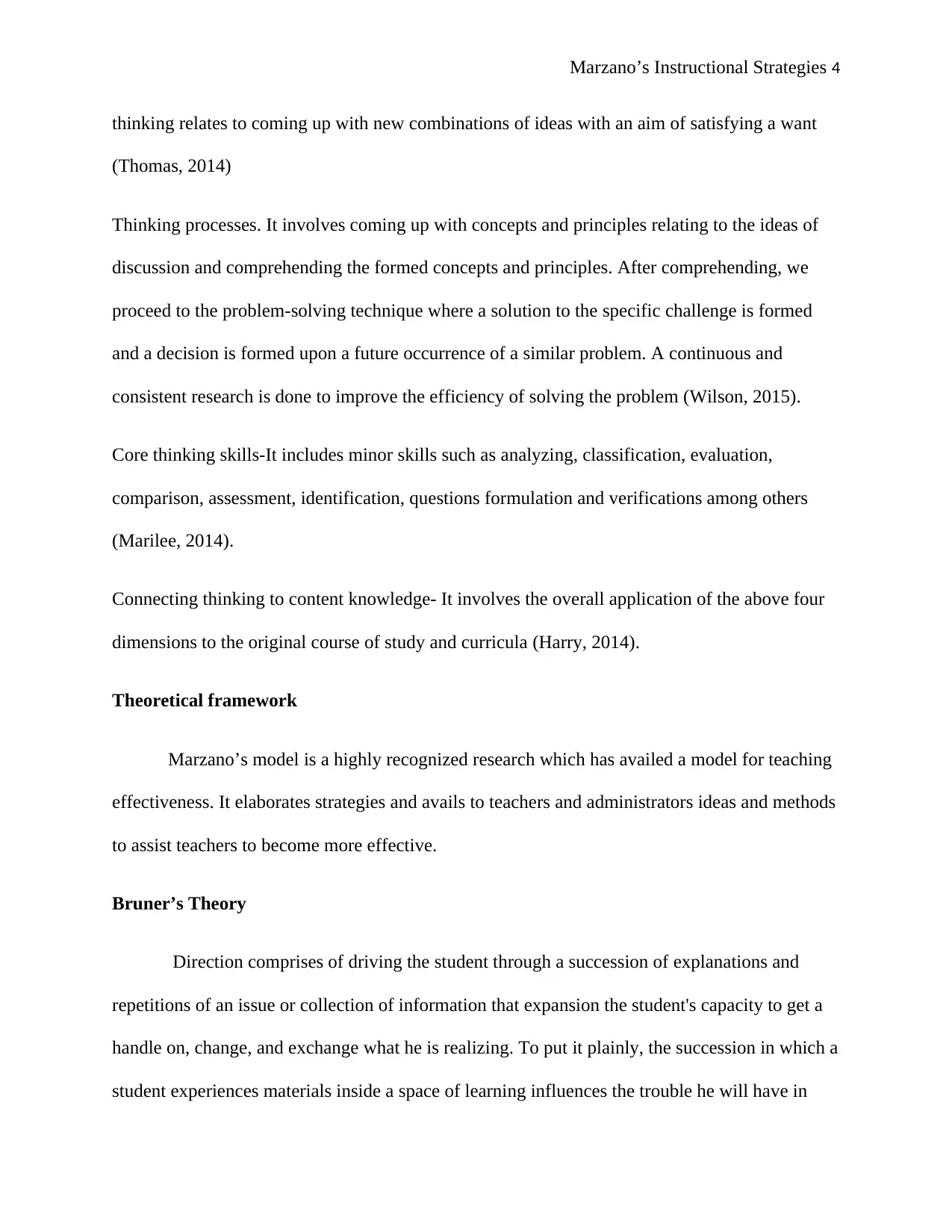
Marzano’s Instructional Strategies 4
thinking relates to coming up with new combinations of ideas with an aim of satisfying a want
(Thomas, 2014)
Thinking processes. It involves coming up with concepts and principles relating to the ideas of
discussion and comprehending the formed concepts and principles. After comprehending, we
proceed to the problem-solving technique where a solution to the specific challenge is formed
and a decision is formed upon a future occurrence of a similar problem. A continuous and
consistent research is done to improve the efficiency of solving the problem (Wilson, 2015).
Core thinking skills-It includes minor skills such as analyzing, classification, evaluation,
comparison, assessment, identification, questions formulation and verifications among others
(Marilee, 2014).
Connecting thinking to content knowledge- It involves the overall application of the above four
dimensions to the original course of study and curricula (Harry, 2014).
Theoretical framework
Marzano’s model is a highly recognized research which has availed a model for teaching
effectiveness. It elaborates strategies and avails to teachers and administrators ideas and methods
to assist teachers to become more effective.
Bruner’s Theory
Direction comprises of driving the student through a succession of explanations and
repetitions of an issue or collection of information that expansion the student's capacity to get a
handle on, change, and exchange what he is realizing. To put it plainly, the succession in which a
student experiences materials inside a space of learning influences the trouble he will have in
thinking relates to coming up with new combinations of ideas with an aim of satisfying a want
(Thomas, 2014)
Thinking processes. It involves coming up with concepts and principles relating to the ideas of
discussion and comprehending the formed concepts and principles. After comprehending, we
proceed to the problem-solving technique where a solution to the specific challenge is formed
and a decision is formed upon a future occurrence of a similar problem. A continuous and
consistent research is done to improve the efficiency of solving the problem (Wilson, 2015).
Core thinking skills-It includes minor skills such as analyzing, classification, evaluation,
comparison, assessment, identification, questions formulation and verifications among others
(Marilee, 2014).
Connecting thinking to content knowledge- It involves the overall application of the above four
dimensions to the original course of study and curricula (Harry, 2014).
Theoretical framework
Marzano’s model is a highly recognized research which has availed a model for teaching
effectiveness. It elaborates strategies and avails to teachers and administrators ideas and methods
to assist teachers to become more effective.
Bruner’s Theory
Direction comprises of driving the student through a succession of explanations and
repetitions of an issue or collection of information that expansion the student's capacity to get a
handle on, change, and exchange what he is realizing. To put it plainly, the succession in which a
student experiences materials inside a space of learning influences the trouble he will have in
Paraphrase This Document
Need a fresh take? Get an instant paraphrase of this document with our AI Paraphraser
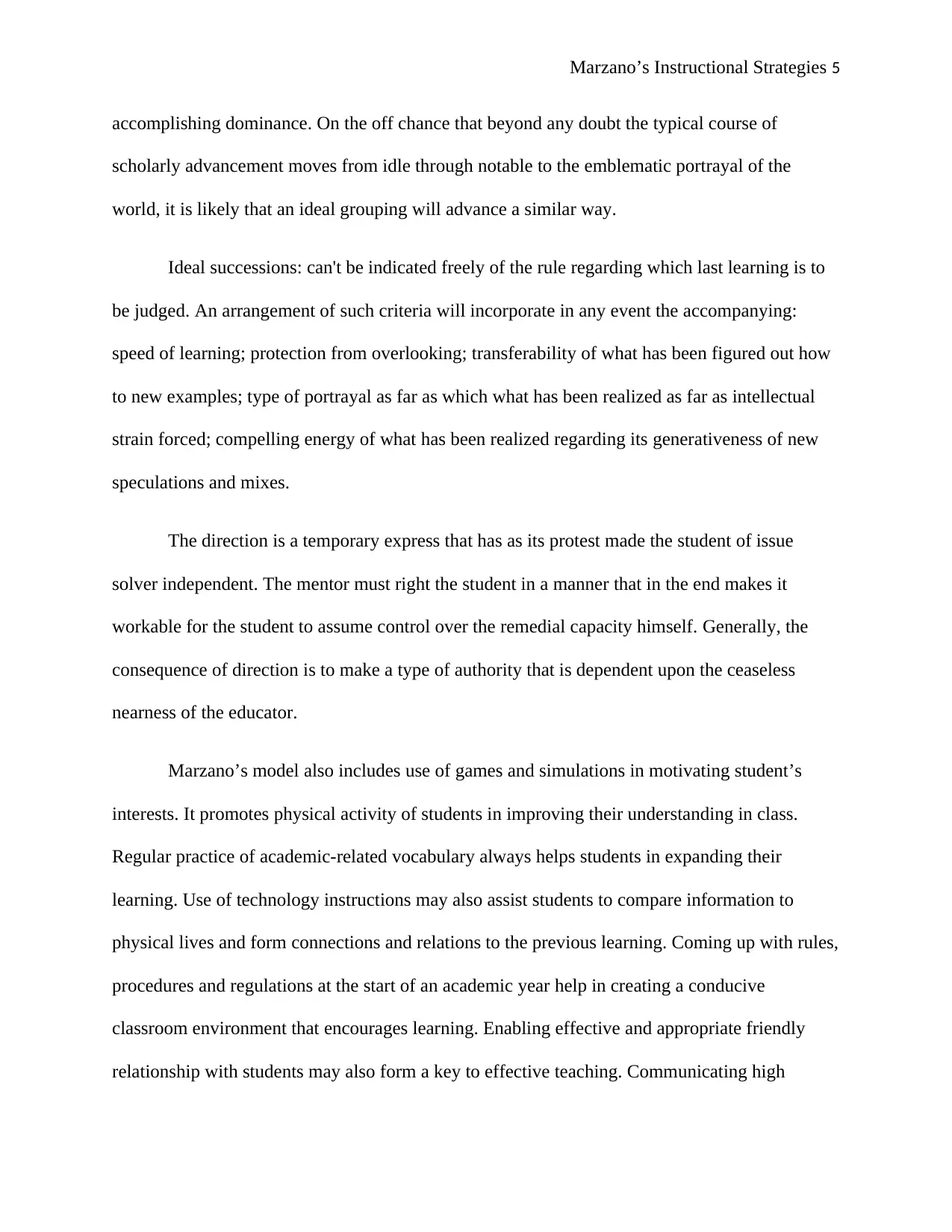
Marzano’s Instructional Strategies 5
accomplishing dominance. On the off chance that beyond any doubt the typical course of
scholarly advancement moves from idle through notable to the emblematic portrayal of the
world, it is likely that an ideal grouping will advance a similar way.
Ideal successions: can't be indicated freely of the rule regarding which last learning is to
be judged. An arrangement of such criteria will incorporate in any event the accompanying:
speed of learning; protection from overlooking; transferability of what has been figured out how
to new examples; type of portrayal as far as which what has been realized as far as intellectual
strain forced; compelling energy of what has been realized regarding its generativeness of new
speculations and mixes.
The direction is a temporary express that has as its protest made the student of issue
solver independent. The mentor must right the student in a manner that in the end makes it
workable for the student to assume control over the remedial capacity himself. Generally, the
consequence of direction is to make a type of authority that is dependent upon the ceaseless
nearness of the educator.
Marzano’s model also includes use of games and simulations in motivating student’s
interests. It promotes physical activity of students in improving their understanding in class.
Regular practice of academic-related vocabulary always helps students in expanding their
learning. Use of technology instructions may also assist students to compare information to
physical lives and form connections and relations to the previous learning. Coming up with rules,
procedures and regulations at the start of an academic year help in creating a conducive
classroom environment that encourages learning. Enabling effective and appropriate friendly
relationship with students may also form a key to effective teaching. Communicating high
accomplishing dominance. On the off chance that beyond any doubt the typical course of
scholarly advancement moves from idle through notable to the emblematic portrayal of the
world, it is likely that an ideal grouping will advance a similar way.
Ideal successions: can't be indicated freely of the rule regarding which last learning is to
be judged. An arrangement of such criteria will incorporate in any event the accompanying:
speed of learning; protection from overlooking; transferability of what has been figured out how
to new examples; type of portrayal as far as which what has been realized as far as intellectual
strain forced; compelling energy of what has been realized regarding its generativeness of new
speculations and mixes.
The direction is a temporary express that has as its protest made the student of issue
solver independent. The mentor must right the student in a manner that in the end makes it
workable for the student to assume control over the remedial capacity himself. Generally, the
consequence of direction is to make a type of authority that is dependent upon the ceaseless
nearness of the educator.
Marzano’s model also includes use of games and simulations in motivating student’s
interests. It promotes physical activity of students in improving their understanding in class.
Regular practice of academic-related vocabulary always helps students in expanding their
learning. Use of technology instructions may also assist students to compare information to
physical lives and form connections and relations to the previous learning. Coming up with rules,
procedures and regulations at the start of an academic year help in creating a conducive
classroom environment that encourages learning. Enabling effective and appropriate friendly
relationship with students may also form a key to effective teaching. Communicating high
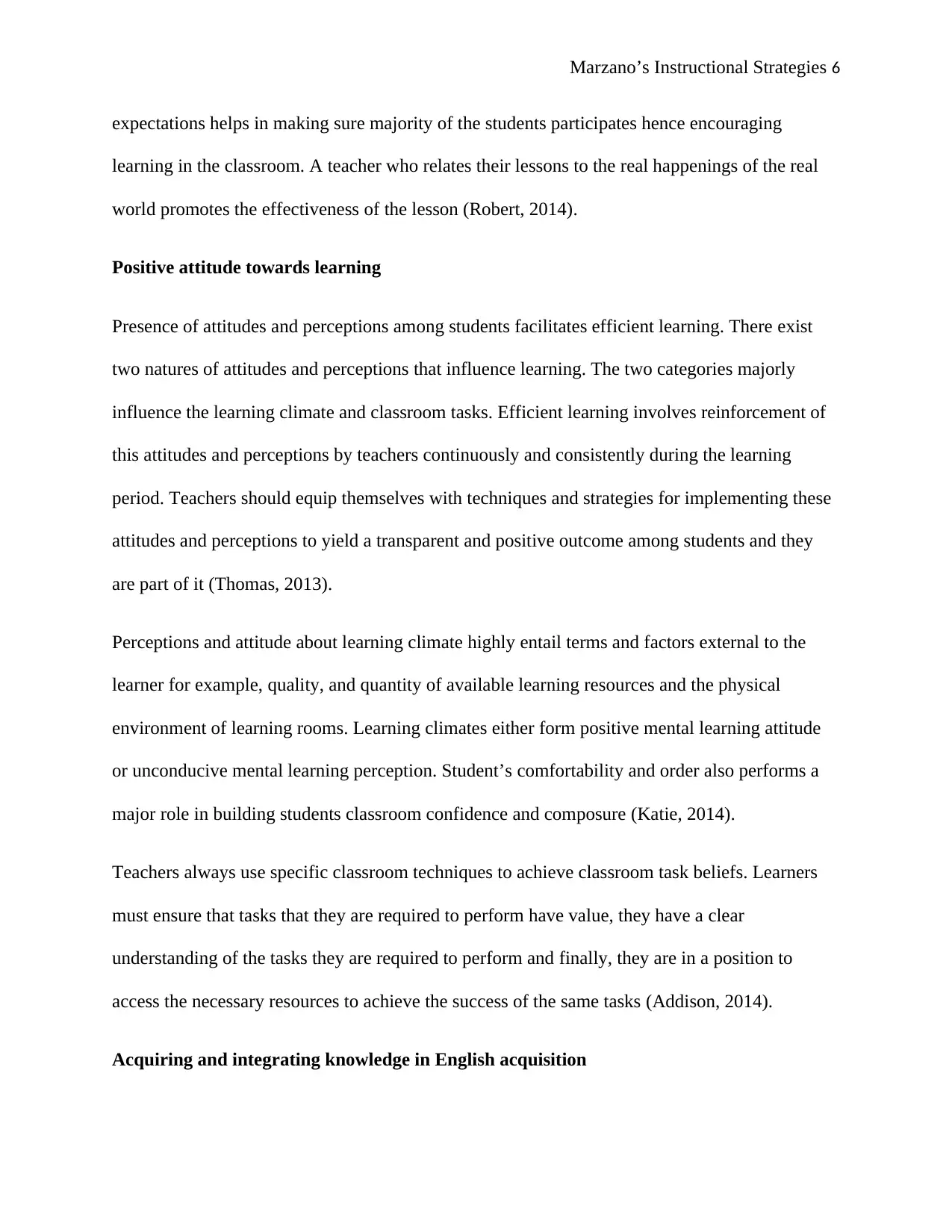
Marzano’s Instructional Strategies 6
expectations helps in making sure majority of the students participates hence encouraging
learning in the classroom. A teacher who relates their lessons to the real happenings of the real
world promotes the effectiveness of the lesson (Robert, 2014).
Positive attitude towards learning
Presence of attitudes and perceptions among students facilitates efficient learning. There exist
two natures of attitudes and perceptions that influence learning. The two categories majorly
influence the learning climate and classroom tasks. Efficient learning involves reinforcement of
this attitudes and perceptions by teachers continuously and consistently during the learning
period. Teachers should equip themselves with techniques and strategies for implementing these
attitudes and perceptions to yield a transparent and positive outcome among students and they
are part of it (Thomas, 2013).
Perceptions and attitude about learning climate highly entail terms and factors external to the
learner for example, quality, and quantity of available learning resources and the physical
environment of learning rooms. Learning climates either form positive mental learning attitude
or unconducive mental learning perception. Student’s comfortability and order also performs a
major role in building students classroom confidence and composure (Katie, 2014).
Teachers always use specific classroom techniques to achieve classroom task beliefs. Learners
must ensure that tasks that they are required to perform have value, they have a clear
understanding of the tasks they are required to perform and finally, they are in a position to
access the necessary resources to achieve the success of the same tasks (Addison, 2014).
Acquiring and integrating knowledge in English acquisition
expectations helps in making sure majority of the students participates hence encouraging
learning in the classroom. A teacher who relates their lessons to the real happenings of the real
world promotes the effectiveness of the lesson (Robert, 2014).
Positive attitude towards learning
Presence of attitudes and perceptions among students facilitates efficient learning. There exist
two natures of attitudes and perceptions that influence learning. The two categories majorly
influence the learning climate and classroom tasks. Efficient learning involves reinforcement of
this attitudes and perceptions by teachers continuously and consistently during the learning
period. Teachers should equip themselves with techniques and strategies for implementing these
attitudes and perceptions to yield a transparent and positive outcome among students and they
are part of it (Thomas, 2013).
Perceptions and attitude about learning climate highly entail terms and factors external to the
learner for example, quality, and quantity of available learning resources and the physical
environment of learning rooms. Learning climates either form positive mental learning attitude
or unconducive mental learning perception. Student’s comfortability and order also performs a
major role in building students classroom confidence and composure (Katie, 2014).
Teachers always use specific classroom techniques to achieve classroom task beliefs. Learners
must ensure that tasks that they are required to perform have value, they have a clear
understanding of the tasks they are required to perform and finally, they are in a position to
access the necessary resources to achieve the success of the same tasks (Addison, 2014).
Acquiring and integrating knowledge in English acquisition
⊘ This is a preview!⊘
Do you want full access?
Subscribe today to unlock all pages.

Trusted by 1+ million students worldwide
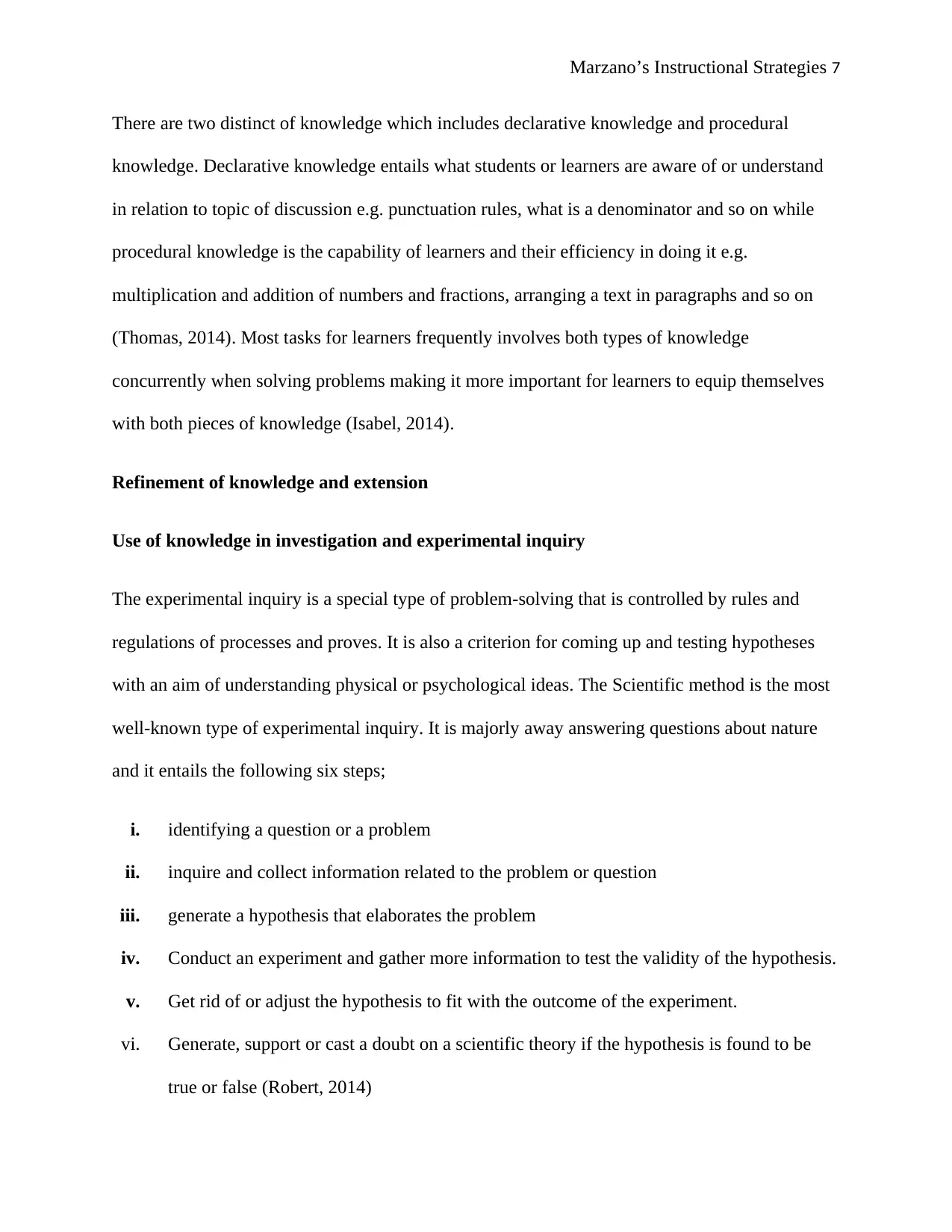
Marzano’s Instructional Strategies 7
There are two distinct of knowledge which includes declarative knowledge and procedural
knowledge. Declarative knowledge entails what students or learners are aware of or understand
in relation to topic of discussion e.g. punctuation rules, what is a denominator and so on while
procedural knowledge is the capability of learners and their efficiency in doing it e.g.
multiplication and addition of numbers and fractions, arranging a text in paragraphs and so on
(Thomas, 2014). Most tasks for learners frequently involves both types of knowledge
concurrently when solving problems making it more important for learners to equip themselves
with both pieces of knowledge (Isabel, 2014).
Refinement of knowledge and extension
Use of knowledge in investigation and experimental inquiry
The experimental inquiry is a special type of problem-solving that is controlled by rules and
regulations of processes and proves. It is also a criterion for coming up and testing hypotheses
with an aim of understanding physical or psychological ideas. The Scientific method is the most
well-known type of experimental inquiry. It is majorly away answering questions about nature
and it entails the following six steps;
i. identifying a question or a problem
ii. inquire and collect information related to the problem or question
iii. generate a hypothesis that elaborates the problem
iv. Conduct an experiment and gather more information to test the validity of the hypothesis.
v. Get rid of or adjust the hypothesis to fit with the outcome of the experiment.
vi. Generate, support or cast a doubt on a scientific theory if the hypothesis is found to be
true or false (Robert, 2014)
There are two distinct of knowledge which includes declarative knowledge and procedural
knowledge. Declarative knowledge entails what students or learners are aware of or understand
in relation to topic of discussion e.g. punctuation rules, what is a denominator and so on while
procedural knowledge is the capability of learners and their efficiency in doing it e.g.
multiplication and addition of numbers and fractions, arranging a text in paragraphs and so on
(Thomas, 2014). Most tasks for learners frequently involves both types of knowledge
concurrently when solving problems making it more important for learners to equip themselves
with both pieces of knowledge (Isabel, 2014).
Refinement of knowledge and extension
Use of knowledge in investigation and experimental inquiry
The experimental inquiry is a special type of problem-solving that is controlled by rules and
regulations of processes and proves. It is also a criterion for coming up and testing hypotheses
with an aim of understanding physical or psychological ideas. The Scientific method is the most
well-known type of experimental inquiry. It is majorly away answering questions about nature
and it entails the following six steps;
i. identifying a question or a problem
ii. inquire and collect information related to the problem or question
iii. generate a hypothesis that elaborates the problem
iv. Conduct an experiment and gather more information to test the validity of the hypothesis.
v. Get rid of or adjust the hypothesis to fit with the outcome of the experiment.
vi. Generate, support or cast a doubt on a scientific theory if the hypothesis is found to be
true or false (Robert, 2014)
Paraphrase This Document
Need a fresh take? Get an instant paraphrase of this document with our AI Paraphraser
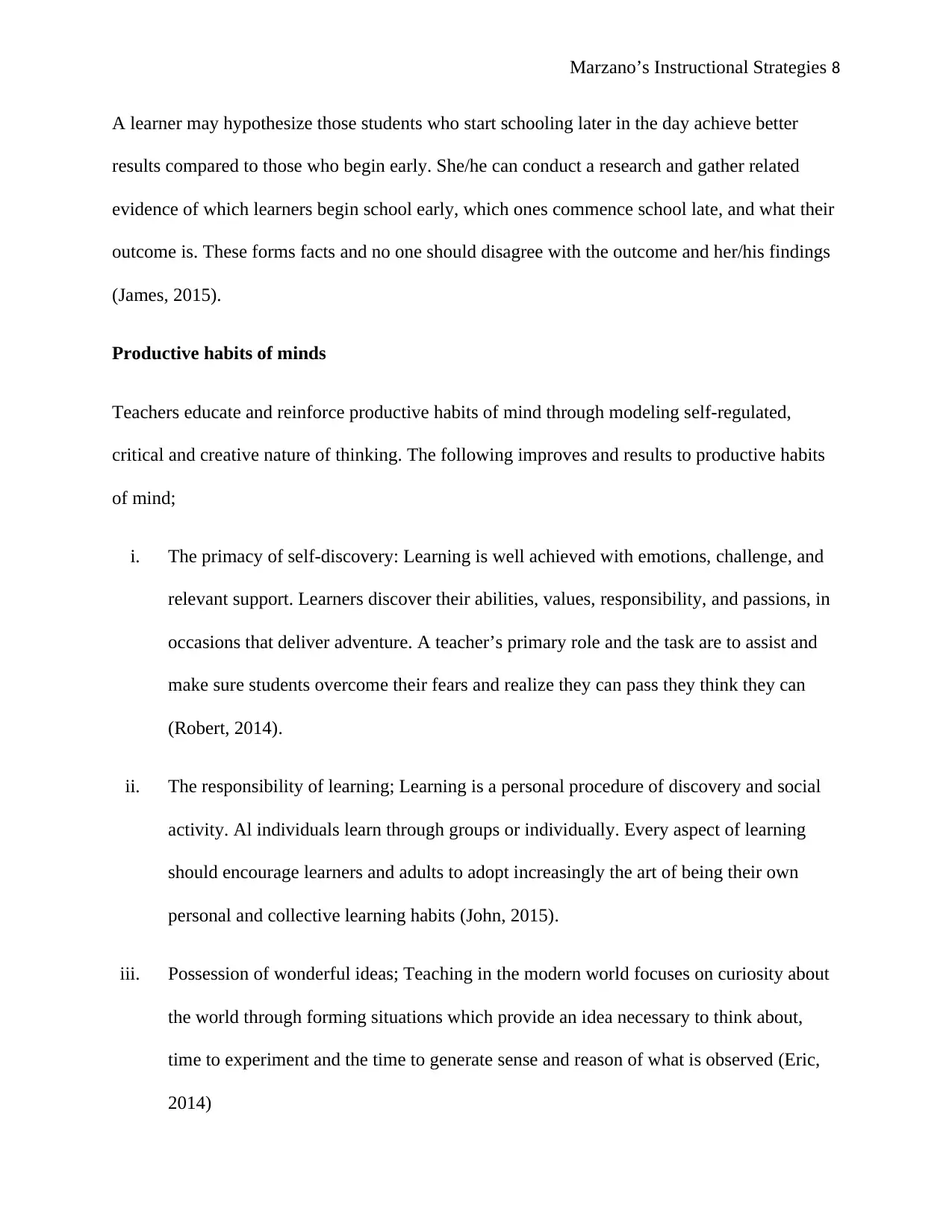
Marzano’s Instructional Strategies 8
A learner may hypothesize those students who start schooling later in the day achieve better
results compared to those who begin early. She/he can conduct a research and gather related
evidence of which learners begin school early, which ones commence school late, and what their
outcome is. These forms facts and no one should disagree with the outcome and her/his findings
(James, 2015).
Productive habits of minds
Teachers educate and reinforce productive habits of mind through modeling self-regulated,
critical and creative nature of thinking. The following improves and results to productive habits
of mind;
i. The primacy of self-discovery: Learning is well achieved with emotions, challenge, and
relevant support. Learners discover their abilities, values, responsibility, and passions, in
occasions that deliver adventure. A teacher’s primary role and the task are to assist and
make sure students overcome their fears and realize they can pass they think they can
(Robert, 2014).
ii. The responsibility of learning; Learning is a personal procedure of discovery and social
activity. Al individuals learn through groups or individually. Every aspect of learning
should encourage learners and adults to adopt increasingly the art of being their own
personal and collective learning habits (John, 2015).
iii. Possession of wonderful ideas; Teaching in the modern world focuses on curiosity about
the world through forming situations which provide an idea necessary to think about,
time to experiment and the time to generate sense and reason of what is observed (Eric,
2014)
A learner may hypothesize those students who start schooling later in the day achieve better
results compared to those who begin early. She/he can conduct a research and gather related
evidence of which learners begin school early, which ones commence school late, and what their
outcome is. These forms facts and no one should disagree with the outcome and her/his findings
(James, 2015).
Productive habits of minds
Teachers educate and reinforce productive habits of mind through modeling self-regulated,
critical and creative nature of thinking. The following improves and results to productive habits
of mind;
i. The primacy of self-discovery: Learning is well achieved with emotions, challenge, and
relevant support. Learners discover their abilities, values, responsibility, and passions, in
occasions that deliver adventure. A teacher’s primary role and the task are to assist and
make sure students overcome their fears and realize they can pass they think they can
(Robert, 2014).
ii. The responsibility of learning; Learning is a personal procedure of discovery and social
activity. Al individuals learn through groups or individually. Every aspect of learning
should encourage learners and adults to adopt increasingly the art of being their own
personal and collective learning habits (John, 2015).
iii. Possession of wonderful ideas; Teaching in the modern world focuses on curiosity about
the world through forming situations which provide an idea necessary to think about,
time to experiment and the time to generate sense and reason of what is observed (Eric,
2014)
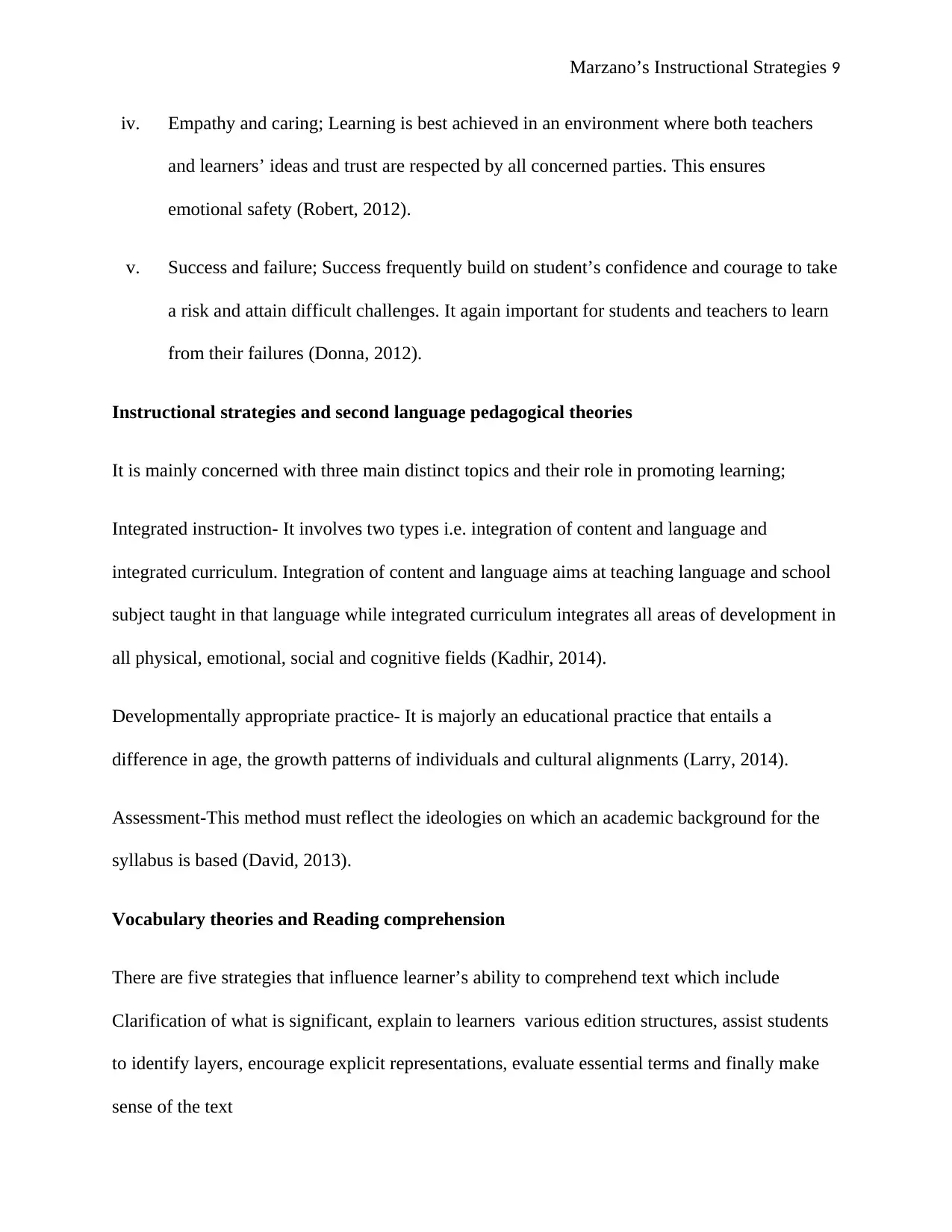
Marzano’s Instructional Strategies 9
iv. Empathy and caring; Learning is best achieved in an environment where both teachers
and learners’ ideas and trust are respected by all concerned parties. This ensures
emotional safety (Robert, 2012).
v. Success and failure; Success frequently build on student’s confidence and courage to take
a risk and attain difficult challenges. It again important for students and teachers to learn
from their failures (Donna, 2012).
Instructional strategies and second language pedagogical theories
It is mainly concerned with three main distinct topics and their role in promoting learning;
Integrated instruction- It involves two types i.e. integration of content and language and
integrated curriculum. Integration of content and language aims at teaching language and school
subject taught in that language while integrated curriculum integrates all areas of development in
all physical, emotional, social and cognitive fields (Kadhir, 2014).
Developmentally appropriate practice- It is majorly an educational practice that entails a
difference in age, the growth patterns of individuals and cultural alignments (Larry, 2014).
Assessment-This method must reflect the ideologies on which an academic background for the
syllabus is based (David, 2013).
Vocabulary theories and Reading comprehension
There are five strategies that influence learner’s ability to comprehend text which include
Clarification of what is significant, explain to learners various edition structures, assist students
to identify layers, encourage explicit representations, evaluate essential terms and finally make
sense of the text
iv. Empathy and caring; Learning is best achieved in an environment where both teachers
and learners’ ideas and trust are respected by all concerned parties. This ensures
emotional safety (Robert, 2012).
v. Success and failure; Success frequently build on student’s confidence and courage to take
a risk and attain difficult challenges. It again important for students and teachers to learn
from their failures (Donna, 2012).
Instructional strategies and second language pedagogical theories
It is mainly concerned with three main distinct topics and their role in promoting learning;
Integrated instruction- It involves two types i.e. integration of content and language and
integrated curriculum. Integration of content and language aims at teaching language and school
subject taught in that language while integrated curriculum integrates all areas of development in
all physical, emotional, social and cognitive fields (Kadhir, 2014).
Developmentally appropriate practice- It is majorly an educational practice that entails a
difference in age, the growth patterns of individuals and cultural alignments (Larry, 2014).
Assessment-This method must reflect the ideologies on which an academic background for the
syllabus is based (David, 2013).
Vocabulary theories and Reading comprehension
There are five strategies that influence learner’s ability to comprehend text which include
Clarification of what is significant, explain to learners various edition structures, assist students
to identify layers, encourage explicit representations, evaluate essential terms and finally make
sense of the text
⊘ This is a preview!⊘
Do you want full access?
Subscribe today to unlock all pages.

Trusted by 1+ million students worldwide
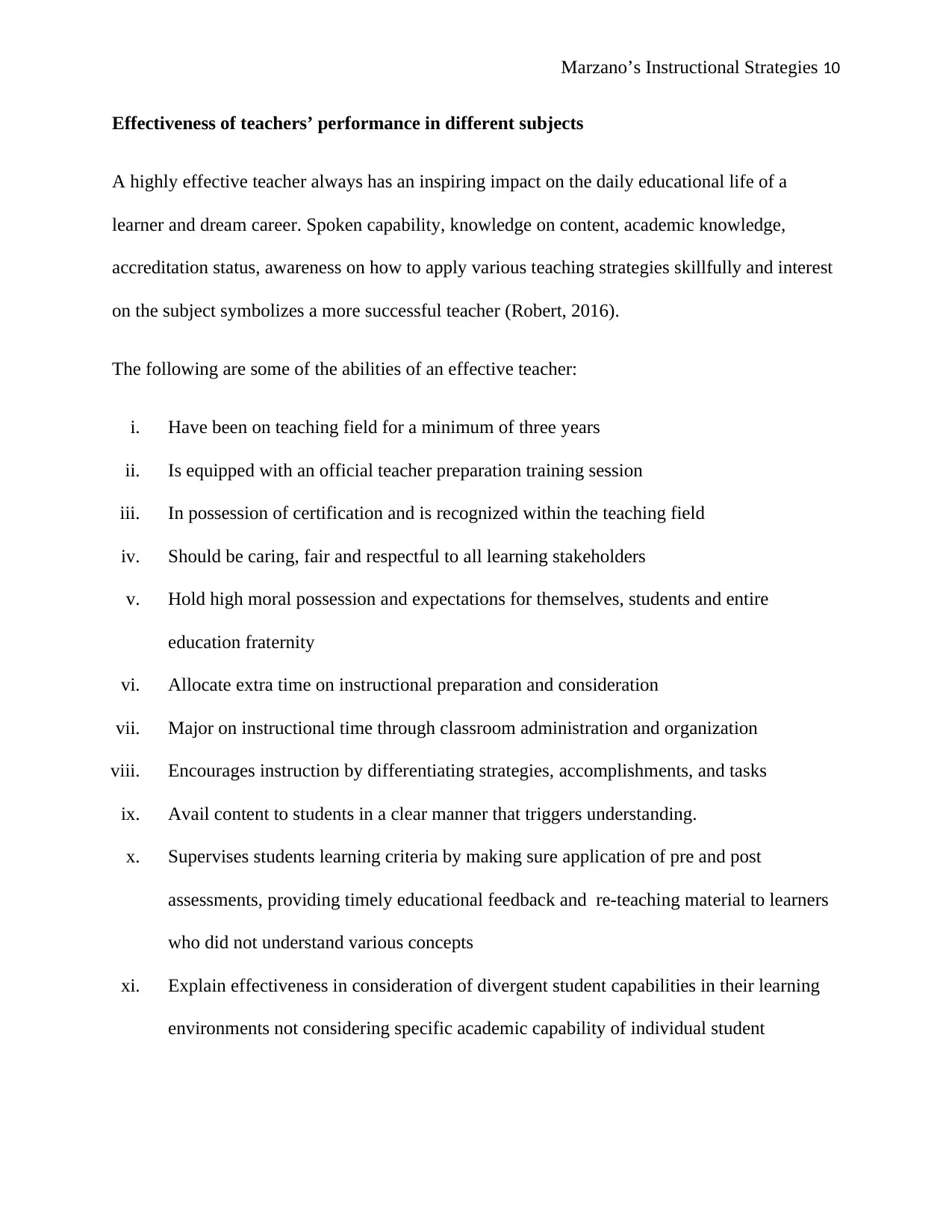
Marzano’s Instructional Strategies 10
Effectiveness of teachers’ performance in different subjects
A highly effective teacher always has an inspiring impact on the daily educational life of a
learner and dream career. Spoken capability, knowledge on content, academic knowledge,
accreditation status, awareness on how to apply various teaching strategies skillfully and interest
on the subject symbolizes a more successful teacher (Robert, 2016).
The following are some of the abilities of an effective teacher:
i. Have been on teaching field for a minimum of three years
ii. Is equipped with an official teacher preparation training session
iii. In possession of certification and is recognized within the teaching field
iv. Should be caring, fair and respectful to all learning stakeholders
v. Hold high moral possession and expectations for themselves, students and entire
education fraternity
vi. Allocate extra time on instructional preparation and consideration
vii. Major on instructional time through classroom administration and organization
viii. Encourages instruction by differentiating strategies, accomplishments, and tasks
ix. Avail content to students in a clear manner that triggers understanding.
x. Supervises students learning criteria by making sure application of pre and post
assessments, providing timely educational feedback and re-teaching material to learners
who did not understand various concepts
xi. Explain effectiveness in consideration of divergent student capabilities in their learning
environments not considering specific academic capability of individual student
Effectiveness of teachers’ performance in different subjects
A highly effective teacher always has an inspiring impact on the daily educational life of a
learner and dream career. Spoken capability, knowledge on content, academic knowledge,
accreditation status, awareness on how to apply various teaching strategies skillfully and interest
on the subject symbolizes a more successful teacher (Robert, 2016).
The following are some of the abilities of an effective teacher:
i. Have been on teaching field for a minimum of three years
ii. Is equipped with an official teacher preparation training session
iii. In possession of certification and is recognized within the teaching field
iv. Should be caring, fair and respectful to all learning stakeholders
v. Hold high moral possession and expectations for themselves, students and entire
education fraternity
vi. Allocate extra time on instructional preparation and consideration
vii. Major on instructional time through classroom administration and organization
viii. Encourages instruction by differentiating strategies, accomplishments, and tasks
ix. Avail content to students in a clear manner that triggers understanding.
x. Supervises students learning criteria by making sure application of pre and post
assessments, providing timely educational feedback and re-teaching material to learners
who did not understand various concepts
xi. Explain effectiveness in consideration of divergent student capabilities in their learning
environments not considering specific academic capability of individual student
Paraphrase This Document
Need a fresh take? Get an instant paraphrase of this document with our AI Paraphraser
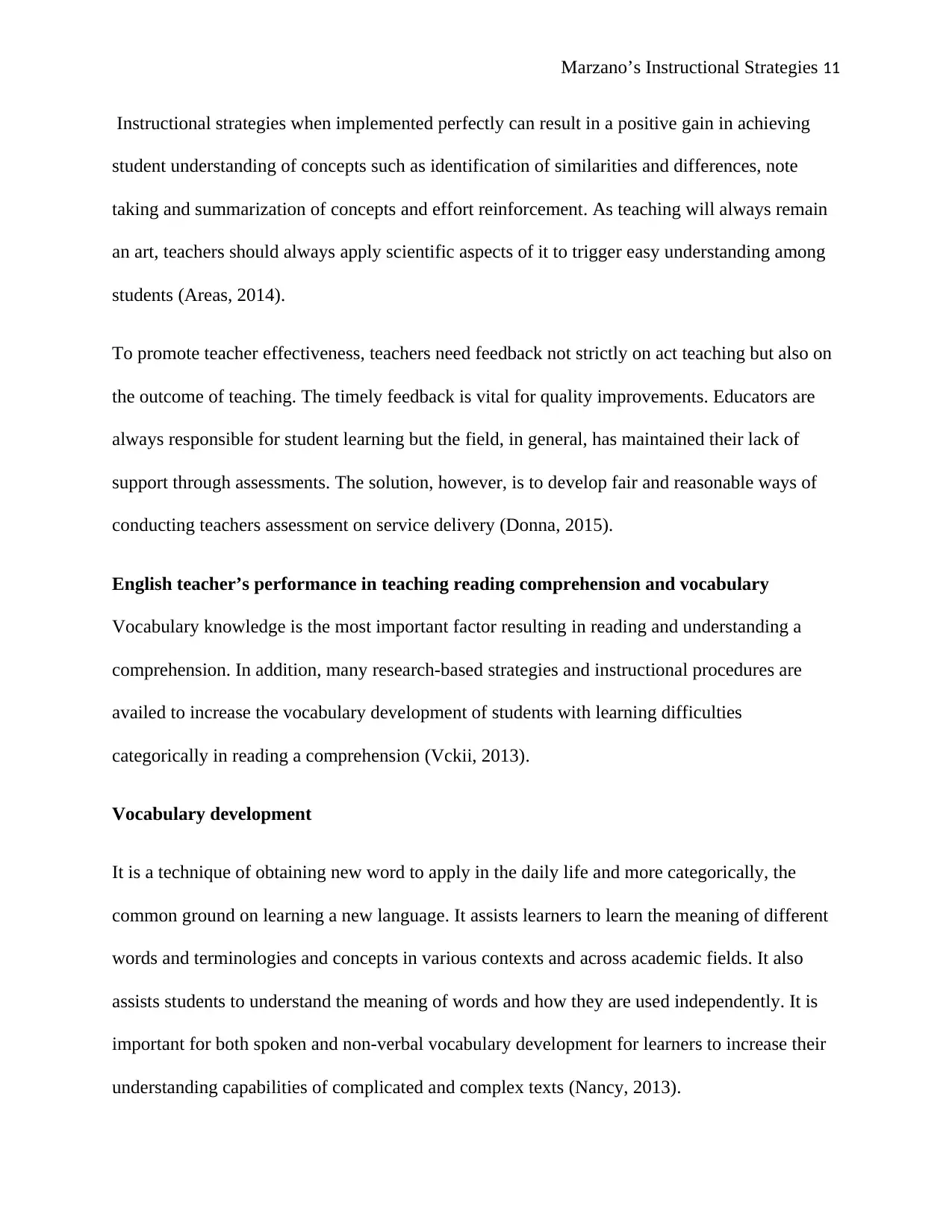
Marzano’s Instructional Strategies 11
Instructional strategies when implemented perfectly can result in a positive gain in achieving
student understanding of concepts such as identification of similarities and differences, note
taking and summarization of concepts and effort reinforcement. As teaching will always remain
an art, teachers should always apply scientific aspects of it to trigger easy understanding among
students (Areas, 2014).
To promote teacher effectiveness, teachers need feedback not strictly on act teaching but also on
the outcome of teaching. The timely feedback is vital for quality improvements. Educators are
always responsible for student learning but the field, in general, has maintained their lack of
support through assessments. The solution, however, is to develop fair and reasonable ways of
conducting teachers assessment on service delivery (Donna, 2015).
English teacher’s performance in teaching reading comprehension and vocabulary
Vocabulary knowledge is the most important factor resulting in reading and understanding a
comprehension. In addition, many research-based strategies and instructional procedures are
availed to increase the vocabulary development of students with learning difficulties
categorically in reading a comprehension (Vckii, 2013).
Vocabulary development
It is a technique of obtaining new word to apply in the daily life and more categorically, the
common ground on learning a new language. It assists learners to learn the meaning of different
words and terminologies and concepts in various contexts and across academic fields. It also
assists students to understand the meaning of words and how they are used independently. It is
important for both spoken and non-verbal vocabulary development for learners to increase their
understanding capabilities of complicated and complex texts (Nancy, 2013).
Instructional strategies when implemented perfectly can result in a positive gain in achieving
student understanding of concepts such as identification of similarities and differences, note
taking and summarization of concepts and effort reinforcement. As teaching will always remain
an art, teachers should always apply scientific aspects of it to trigger easy understanding among
students (Areas, 2014).
To promote teacher effectiveness, teachers need feedback not strictly on act teaching but also on
the outcome of teaching. The timely feedback is vital for quality improvements. Educators are
always responsible for student learning but the field, in general, has maintained their lack of
support through assessments. The solution, however, is to develop fair and reasonable ways of
conducting teachers assessment on service delivery (Donna, 2015).
English teacher’s performance in teaching reading comprehension and vocabulary
Vocabulary knowledge is the most important factor resulting in reading and understanding a
comprehension. In addition, many research-based strategies and instructional procedures are
availed to increase the vocabulary development of students with learning difficulties
categorically in reading a comprehension (Vckii, 2013).
Vocabulary development
It is a technique of obtaining new word to apply in the daily life and more categorically, the
common ground on learning a new language. It assists learners to learn the meaning of different
words and terminologies and concepts in various contexts and across academic fields. It also
assists students to understand the meaning of words and how they are used independently. It is
important for both spoken and non-verbal vocabulary development for learners to increase their
understanding capabilities of complicated and complex texts (Nancy, 2013).
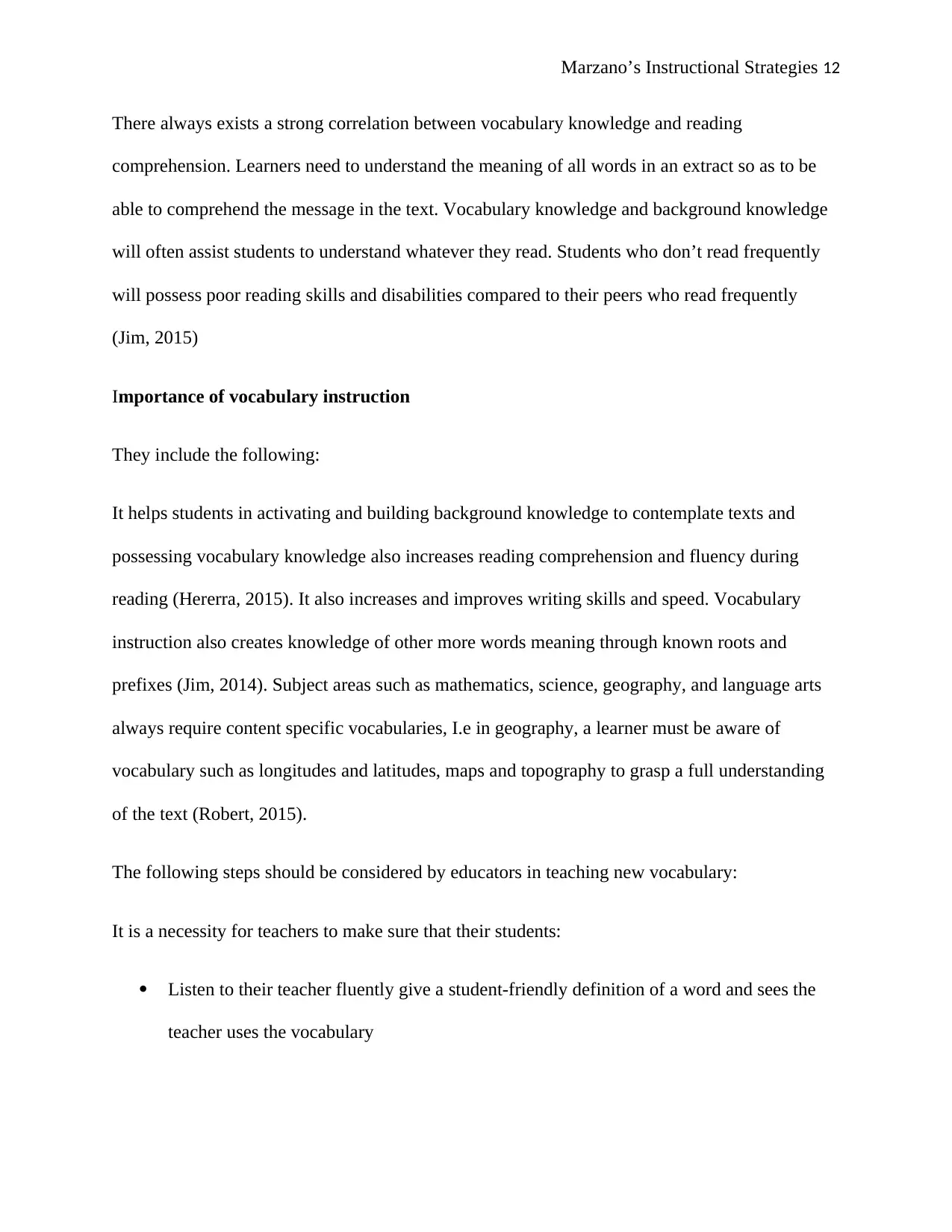
Marzano’s Instructional Strategies 12
There always exists a strong correlation between vocabulary knowledge and reading
comprehension. Learners need to understand the meaning of all words in an extract so as to be
able to comprehend the message in the text. Vocabulary knowledge and background knowledge
will often assist students to understand whatever they read. Students who don’t read frequently
will possess poor reading skills and disabilities compared to their peers who read frequently
(Jim, 2015)
Importance of vocabulary instruction
They include the following:
It helps students in activating and building background knowledge to contemplate texts and
possessing vocabulary knowledge also increases reading comprehension and fluency during
reading (Hererra, 2015). It also increases and improves writing skills and speed. Vocabulary
instruction also creates knowledge of other more words meaning through known roots and
prefixes (Jim, 2014). Subject areas such as mathematics, science, geography, and language arts
always require content specific vocabularies, I.e in geography, a learner must be aware of
vocabulary such as longitudes and latitudes, maps and topography to grasp a full understanding
of the text (Robert, 2015).
The following steps should be considered by educators in teaching new vocabulary:
It is a necessity for teachers to make sure that their students:
Listen to their teacher fluently give a student-friendly definition of a word and sees the
teacher uses the vocabulary
There always exists a strong correlation between vocabulary knowledge and reading
comprehension. Learners need to understand the meaning of all words in an extract so as to be
able to comprehend the message in the text. Vocabulary knowledge and background knowledge
will often assist students to understand whatever they read. Students who don’t read frequently
will possess poor reading skills and disabilities compared to their peers who read frequently
(Jim, 2015)
Importance of vocabulary instruction
They include the following:
It helps students in activating and building background knowledge to contemplate texts and
possessing vocabulary knowledge also increases reading comprehension and fluency during
reading (Hererra, 2015). It also increases and improves writing skills and speed. Vocabulary
instruction also creates knowledge of other more words meaning through known roots and
prefixes (Jim, 2014). Subject areas such as mathematics, science, geography, and language arts
always require content specific vocabularies, I.e in geography, a learner must be aware of
vocabulary such as longitudes and latitudes, maps and topography to grasp a full understanding
of the text (Robert, 2015).
The following steps should be considered by educators in teaching new vocabulary:
It is a necessity for teachers to make sure that their students:
Listen to their teacher fluently give a student-friendly definition of a word and sees the
teacher uses the vocabulary
⊘ This is a preview!⊘
Do you want full access?
Subscribe today to unlock all pages.

Trusted by 1+ million students worldwide
1 out of 25
Related Documents
Your All-in-One AI-Powered Toolkit for Academic Success.
+13062052269
info@desklib.com
Available 24*7 on WhatsApp / Email
![[object Object]](/_next/static/media/star-bottom.7253800d.svg)
Unlock your academic potential
Copyright © 2020–2025 A2Z Services. All Rights Reserved. Developed and managed by ZUCOL.




